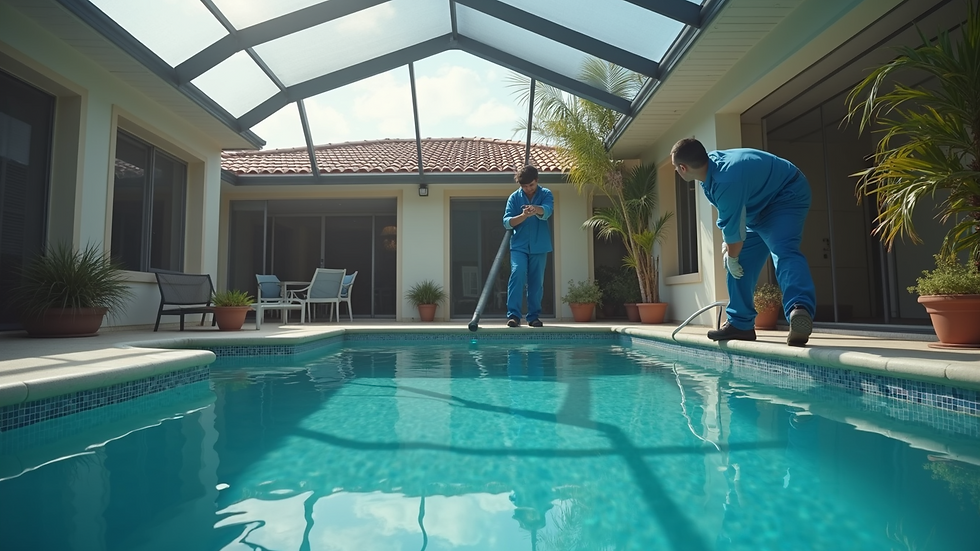Top Pool Screen Problems and Solutions
- Sunbay Screen Solutions
- Sep 15
- 4 min read
A pool screen enclosure is a fantastic addition to any pool area. It keeps bugs out, reduces debris, and adds a layer of safety. But like any outdoor structure, pool screens can face issues over time. I’ve seen many homeowners and property managers in Central Florida deal with these problems. The good news? Most pool screen repairs are straightforward and can save you a lot of hassle if addressed early.
Let’s dive into the most common pool screen problems and how you can fix them quickly and effectively.
Identifying Common Pool Screen Problems
Before jumping into repairs, it’s important to know what issues to look for. Pool screens are exposed to sun, wind, rain, and sometimes storms. These elements can cause wear and tear. Here are the top problems I’ve encountered:
Tears and Holes: Small rips can quickly turn into bigger holes if not fixed.
Loose or Sagging Screens: Over time, screens can lose tension and sag.
Damaged Frames: Frames can bend, rust, or break, affecting the screen’s stability.
Corrosion and Rust: Metal parts exposed to moisture may corrode.
Screen Discoloration: Sun exposure can fade or weaken the screen material.
Knowing these issues helps you spot problems early and decide if you can handle repairs yourself or need professional help.

Pool Screen Repairs: Step-by-Step Solutions
When it comes to pool screen repairs, I always recommend starting with the simplest fixes. Here’s a practical guide to tackle the most common problems:
Fixing Tears and Holes
Small tears are the easiest to repair. You can use a screen repair kit available at most hardware stores. These kits usually include patches and adhesive.
Steps:
Clean the damaged area with mild soap and water.
Cut a patch slightly larger than the hole.
Apply adhesive around the hole.
Press the patch firmly over the tear.
Let it dry completely before touching.
For larger holes or multiple tears, replacing the entire screen panel might be necessary.
Tightening Loose or Sagging Screens
Screens lose tension due to weather or improper installation. To fix sagging:
Use a spline roller tool to press the screen back into the frame groove.
Replace the spline (the rubber strip holding the screen) if it’s worn out.
Pull the screen taut before pressing it in to avoid wrinkles.
This simple fix can restore your screen’s appearance and function.
Repairing Damaged Frames
Frames can bend or break from storms or accidents. Minor bends can sometimes be straightened with gentle pressure or a rubber mallet. For rust:
Sand the affected area.
Apply rust-resistant primer and paint.
Replace severely damaged sections.
If the frame damage is extensive, professional replacement is the safest option.

Preventing Corrosion and Rust
Regular maintenance helps prevent corrosion. Here’s what I suggest:
Clean metal frames with mild detergent monthly.
Inspect for rust spots and treat them immediately.
Apply a protective coating or paint every few years.
Avoid using harsh chemicals near the screen enclosure.
These steps extend the life of your pool screen frame and keep it looking great.
Dealing with Screen Discoloration
Sunlight can fade screens, making them brittle. While you can’t reverse fading, you can:
Replace faded panels.
Choose UV-resistant screen materials when replacing.
Use shade cloths or awnings to reduce direct sun exposure.
Regular cleaning also helps maintain the screen’s appearance.
When to Call the Experts for Pool Screen Repairs
Sometimes, DIY fixes aren’t enough. If you notice any of these signs, it’s time to get professional help:
Large tears or multiple damaged panels.
Significant frame damage or instability.
Persistent sagging despite tightening efforts.
Extensive rust or corrosion.
Screens older than 10 years showing wear.
For reliable and high-quality service, I recommend fish hawk pool screen services. They specialize in pool screen repairs and enclosures in Central Florida. Their team is experienced, friendly, and efficient, making the repair process stress-free.

Tips to Maintain Your Pool Screen and Avoid Future Repairs
Prevention is always better than repair. Here are some easy maintenance tips to keep your pool screen in top shape:
Regular Cleaning: Wash screens and frames every few months to remove dirt and debris.
Inspect Often: Check for small tears, loose spline, or rust spots regularly.
Trim Nearby Trees: Branches can scratch or puncture screens during storms.
Avoid Harsh Chemicals: Use pool chemicals carefully to prevent damage to screens.
Schedule Professional Inspections: A yearly check-up by experts can catch problems early.
Following these tips will save you money and keep your pool area safe and enjoyable.
Your Pool Screen’s Best Friend in Central Florida
Living in Central Florida means dealing with intense sun, heavy rains, and occasional storms. Your pool screen enclosure faces a lot. But with the right care and timely repairs, it can last for many years.
If you want peace of mind and expert service, consider reaching out to fish hawk pool screen services. They understand the local climate and offer tailored solutions to keep your pool screen strong and beautiful.
Remember, a well-maintained pool screen not only protects your pool but also enhances your outdoor living experience. Don’t wait for small problems to become big headaches. Take action today and enjoy your pool worry-free!
I hope this guide helps you tackle pool screen repairs with confidence. If you have questions or need professional assistance, don’t hesitate to reach out to trusted experts. Your pool deserves the best care!



Comments